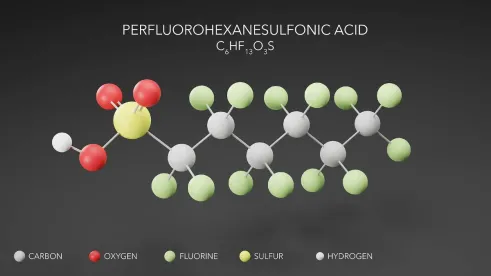In May 2023, Minnesota’s Governor Walz signed into law HF 2310, which bans the sale of certain products containing “intentionally added” per- and- polyfluoroalkyl substances (PFAS) in 2025 and then all products in 2032, and also establishes reporting requirements for products containing PFAS starting in 2026. Following Maine’s lead, Minnesota has now become the second state in the country to pass a broad ban on PFAS-containing products sold in the state. While reporting requirements apply to product manufacturers, the bans on sale, offer for sale, or distribution in the state apply to “persons,” including retailers. Companies that manufacture products for sale (and who sell) products in the state of Minnesota will need to prepare to assess the presence of PFAS in their supply chains in order to comply with these new requirements.
Background
The US Environmental Protection Agency (EPA) has prioritized addressing PFAS through its PFAS Strategic Roadmap, which implements a plan for regulation of PFAS in drinking water, waste, air emissions, and site contamination. However, in the absence of federal restrictions on products containing PFAS, states are forging ahead with more restrictions. In 2023, over 20 states introduced legislation addressing PFAS, including PFAS in products. This trend is expected to continue and create a patchwork of state restrictions on products.
Within the past few years, 12 states have passed statutes that specifically require reporting, disclosures, or otherwise ban certain products containing PFAS such as food packaging, cookware, textiles, cosmetics, furniture, and children’s products. State legislatures have articulated concerns with the health effects of PFAS and perceived harmful exposures to consumers, workers, and the environment coming from products. Notably, all states have adopted the same sweeping definition of PFAS that differs from (and is broader than) EPA’s definition: a class of fluorinated organic chemicals containing at least one fully fluorinated carbon atom. These states regulate PFAS as a class without providing lists of Chemical Abstracts Service Registry Numbers (CASRNs) for easy identification. Further, all states have not established any de minimis level or thresholds for intentionally added PFAS.
The sheer scope of these state laws has subjected potentially millions of products currently sold or distributed in states to various labeling, disclosure, and reporting requirements or bans, creating challenges for companies in ascertaining which of their products are impacted, where those products are impacted, and how to gather the information they need to determine if even trace amounts of PFAS are in their products, or the materials used to manufacture their products.
Experience with Maine PFAS Law
The state of Maine was the first state to pass an expansive reporting requirement and ban for PFAS in all products (consumer, industrial, and commercial) and product components. Maine’s reporting requirements went into effect in January 2023, and the broad ban goes into effect in 2030. The Maine Department of Environmental Protection (DEP) has already experienced significant roadblocks in implementing its law due to issues including a lack of clarity on what information must be reported, delays in availability of DEP’s electronic reporting portal, and uncertainties by companies in understanding what information is needed from their supply chains in order to report. Currently, DEP is working on a rulemaking to address these concerns, and the state legislature is expected to pass legislation revising the statute.
New Minnesota Law
Rather than waiting to learn how the state of Maine will implement and resolve the significant challenges with its broad PFAS law, Minnesota has moved forward to enact legislation very similar to Maine’s law for all products containing PFAS. Minnesota also adds an additional requirement for testing and downstream notification that could add complications for companies. Importantly, the law uniquely provides certain exclusions for pesticides.
Prohibitions
Beginning on January 1, 2025, a person may not sell, offer for sale, or distribute the following products (including product components) if the product contains intentionally added PFAS:
- Carpets or rugs
- Cleaning products (including but not limited to: air care products, automotive maintenance products, general cleaning products, or polish or floor maintenance products)
- Cookware
- Cosmetics
- Dental floss
- Fabric treatments
- Juvenile products (products designed or marketed for use by infants and children under 12 years old)
- Menstruation products
- Textile furnishings
- Ski wax
- Upholstered furniture
The law defines “intentionally added PFAS” as “PFAS deliberately added during the manufacture of a product where the continued presence of PFAS is desired in the final product or one of the product’s components to perform a specific function.”
The law also allows the Minnesota Pollution Control Agency (MPCA) to, by rule, add other products or categories of products to the list of products to be prohibited no earlier than January 1, 2025, but no later than January 1, 2032. MPCA must prioritize banning product categories that MPCA views as most likely to contaminate or harm the state’s environment and natural resources if they contain intentionally added PFAS.
Beginning January 1, 2032, the legislation will prohibit the sale, offer for sale, or distribution in the state of any product (including product components) with intentionally added PFAS unless it can be determined that using such chemicals is currently “unavoidable.” Unavoidable use is defined as a use of PFAS that the MPCA’s Commissioner has determined to be essential for health, safety, or the functioning of society and for which alternatives are not reasonably available.
Notably, the bans for products containing PFAS do not apply to pesticides, fertilizer, agricultural liming material, plant amendment, or soil amendment unless the Minnesota commissioner of agriculture approves the action. No other state to date has included similar exclusions for pesticides.
Notification Requirements
On or before January 1, 2026, a manufacturer of a product (including product components) sold, offered for sale, or distributed in the state that contains intentionally added PFAS must submit to MPCA information that includes:
- A short description of the product, including a Universal Product Code, stock keeping unit (SKU), or other numeric code assigned to the product;
- The purpose for which PFAS is used in the product, including product components;
- The amount of PFAS, identified by its CASRN, in the product, reported as an exact quantity determined using commercially available analytical methods or as falling within a range approved for reporting purposes by the commissioner;
- The name and address of the manufacturer and the name, address, and phone number of a contact person for the manufacturer; and
- Any additional information requested by the commissioner necessary to implement the requirements of this section.
Manufacturers can provide this information for a category or type of product rather than for each individual product. Manufacturers must also update and revise information whenever there is a significant change in information or if requested to do so by MPCA.
Products cannot be sold, offered for sale, or distributed if they contain intentionally added PFAS if the manufacturer has not provided this information to the state. The information requirement can be waived in whole or in part if the commissioner determines that substantially equivalent information is already publicly available, and waivers may be granted for groups of manufacturers for multiple products or product categories.
Pesticides regulated by Minnesota under Chapter 18B, a fertilizer, an agricultural liming material, a plant amendment, or a soil amendment regulated under Chapter 18C can satisfy the reporting requirements by submitting this information required to be reported (listed above) as part of annual registrations.
MPCA has the authority to extend the reporting deadline for manufacturers if it determines more time is needed by the manufacturer to comply with the requirements.
Testing Requirements
If MPCA believes a product contains intentionally added PFAS, and the product is being offered for sale in Minnesota, MPCA may direct the manufacturer of the product to, within 30 days, provide testing results that show the amount of each of the PFAS, identified by its CASRN, in the product, reported as an exact quantity determined using commercially available analytical methods or as falling within a range approved for reporting purposes. If testing demonstrates that a product does not contain PFAS, then a manufacturer must submit a certificate attesting that the product does not contain PFAS (including testing results). If the testing does demonstrate that the product contains intentionally added PFAS, the manufacturer must provide MPCA with the testing results and the information required to be reported to the state.
A manufacturer must notify persons (including retailers) who sell or offer for sale a prohibited product that the sale of that product is prohibited in the state and provide the MPCA with a list of the names and addresses of those notified.
Fees
Further, the law gives MPCA authority to collect fees from manufacturers upon submission of reports and establishes a PFAS manufacturers working group to review options for collecting fees from PFAS manufacturers. The working group will submit a report to the Minnesota legislature with recommendations by February 15, 2024.
Exemptions
HF 2310 does not apply to a product where the presence of PFAS is governed by federal law that preempts state authority, a product regulated under existing laws that regulate PFAS in firefighting foam and food packaging, and the sale or resale of used products. As discussed above, the legislation also authorizes MPCA to enact additional exemptions for products with currently unavoidable uses of PFAS. Testing requirements and product prohibitions do not apply to prosthetic or orthotic devices or to any product that is a medical device or drug or that is otherwise used in a medical setting or in medical applications regulated by the US Food and Drug Administration.








 />i
/>i

